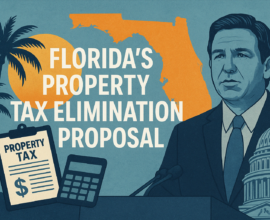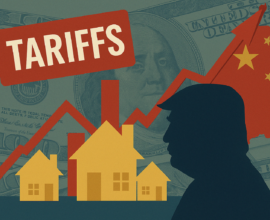Ohio Housing Market Predictions for 2023
Forecasting Ohio’s residential housing market for 2023 poses some challenges. Why? So many variables in the overall U.S. economy are rather extraordinary or extreme. For example, we face the highest mortgage interest rates in more than 15 years, record levels of inflation, and rent prices of roughly double the typical year-to-year average increase (just to name a few).
The short supply of available homes in the Cleveland area was further exacerbated in late 2022 amid escalating interest rates.
Statewide Outlook of Ohio’s Residential Market
Although the home sales volume in Ohio declined substantially at the end of 2022, home prices still rose by more than 4%. The Ohio REALTORS Association remains optimistic based on how the market demonstrated sustainability amid the notable spike in mortgage interest rates. Specifically, the year-end average sales prices increased in half of Ohio’s fourteen housing markets.
According to Realtor.com, overall sales in the housing market should continue at a slow to moderate pace. However, sales activity might surge if the Fed reduces interest rates in the spring or summer months of 2023.
Ohio’s three largest housing markets, or combined statistical areas, include the regions of Cleveland, Columbus, and Cincinnati.
Analysis of the Cleveland Housing Market
Demand for homes in most of the greater-Cleveland area remains strong, partly the result of insufficient inventory. The housing inventory equates to merely 1.3 months, well below the 5 or 6-month level traditionally associated with a healthy real estate market. Simply put, the months’ supply refers to the length of time (months) it would take to deplete the existing homes for sale in a given market.
The short supply of available homes in the Cleveland area was further exacerbated in late 2022 amid escalating interest rates. This should come as no surprise, as existing property owners with a mortgage at 3 or 4% lack the motivation to sell and face rates of 6 or 7% in their next home.
As with most of Ohio, housing in the Cleveland area is affordable in comparison to much of the U.S. The average home value in the region is approximately $236,000.
Many local real estate professionals suggest that investors should look at Cleveland in 2023, as the market should increasingly favor buyers more than sellers. Within the city limits, renters occupy more than half of the housing units; therefore, strong demand exists for rental units — particularly in the single-family rental home market.
Another positive sign for the Cleveland area involves an uptick in investment and development activity. For example, the downtown area recently added 10 acres of green space and many employers are seeking good candidates.
Although home pricing is above-average statewide, the central Ohio region differentiates itself in terms of inventory.
Status of the Housing Market in Columbus
The Columbus market is solid — as Realtor.com ranks the housing market as #14 in the U.S. for 2023. This ranking considers a broad scope of factors, including median income and overall affordability.
Although home pricing is above-average statewide, the central Ohio region differentiates itself in terms of inventory. According to WKBN, more than 3,400 properties are available in the market each month, with more than 1,000 new listings in Franklin County alone.
Despite having a relatively abundant supply, the housing inventory level is only about 1.3 months. The home prices in central Ohio are also strong, with an average value of roughly $280,000, which represents a 7% increase over the prior year.
WCMH, the local NBC affiliate, believes this market will perform well in 2023. For example, they expect home prices to increase by approximately 5% and rental unit pricing to increase by nearly 6% in 2023. While the volume of home sales is expected to decline nationally, Columbus may experience a slight increase.
Investors, particularly those capable of cash offers, should consider Columbus in 2023 for several reasons. Among all of Ohio’s counties, Franklin County ranks as the lowest in owner-occupancy. Data suggests that investors make roughly 17% of all property purchases, which the Affordable Alliance of Central Ohio says is a trend that is increasing.
The Outlook for Cincinnati
Cincinnati is a region traditionally known for overall affordability, with a cost of living that is attractive to young families. Cincinnati has a good supply of single-family homes valued at less than $300,000, and the median sales price for 2022 was over $228,000. For 2023, data from the Cincinnati Business Courier suggested that home prices will climb by over 6%, and Realtor.com projects sales growth of 3%.
One unique aspect of the Cincinnati market is that the traditional surge that occurs in the spring months happens earlier. There were 2,804 closings during January and February 2021 and 2,752 during this period in 2022.
The Cincinnati real estate market represents one part of a very robust overall economic environment. During 2021 and 2022, the greater Cincinnati region boasted capital investments of 1.1 billion dollars and more than 10,000 new jobs. Much of the positive economic activity in the region centers on the realm of small business, such as with the Women’s Business Enterprise Loan Program and Ohio Micro-Enterprise Loan Program.
What Factors Will Impact the Ohio Housing Market in 2023?
Mortgage Rates
The following chart shows the recent monthly rates for a 30-year fixed-rate mortgage:
| October 2022 | 6.89 % |
| November 2022 | 7.23 % |
| December 2022 | 6.67 % |
The comparatively high interest rates in recent months combined with the increased home prices create a lack of affordability; however, economists with the National Association of Realtors maintain optimism. These experts believe that mortgage rates have already “peaked” and anticipate rates of 5.5 to 5.7% for the latter part of 2023 as inflation continues declining.
The Long-Term Housing Deficit
In the 10 years following the Great Recession (2008 to 2018), the construction of new homes fell to levels not seen since the 1960s. In 2019, Fannie Mae estimated that the U.S. had a 3.8 million deficiency in housing units. Next, the 2020 COVID-19 pandemic triggered unprecedented shortages of building supplies, materials, and labor that hindered new home construction.
During the rush of market activity spurred by the pandemic, a lack of supply contributed to the surge in pricing. In the short-term (early 2023), many experts agree that prospective homebuyers will find slightly more options available compared to 2022 because homes will remain on the market longer before selling.
The good news is that new home construction activity is underway in Ohio’s three largest markets.
New Home Construction
The National Association of Home Builders (NAHB) acknowledges that new home construction is vital for satisfying long-term demand. The NAHB explained that the typical inventory of available homes is composed of 90% existing properties and 10% new construction. However, they believe that the new home inventory must exceed 10% in the next couple of years to maintain supply because many existing property owners with 3-4% mortgages will stay put until rates decline.
The NAHB says that more than 60% of new home builders are now offering discounts that average approximately 8% and various other incentives in hopes of attracting buyers. Unfortunately, most builders can’t offer deeper discounts, as the combined surge in inflation and wages (labor) makes it financially impossible.
The good news is that new home construction activity is underway in Ohio’s three largest markets. Some of these specific projects include:
- The Park Ridge Crossings project in the Cleveland suburb of Strongsville will include 33 single-family homes and 100 units composed of attached townhomes and detached cluster homes.
- Grant funding is moving construction forward in southeastern Columbus, as the Fieldstone Cottages project will involve roughly 40 new units.
- Two buildings are being constructed on the site of the former Starling Middle School in Columbus that will accommodate approximately 97 housing units.
- The Federal Home Loan Bank of Cincinnati is funding two local new residential projects as part of their Affordable Housing Program, which specifically creates homes for those with incomes of under $52,500.
Despite having a below-average population growth rate and the recent decline in sales activity, real property values show no signs of weakness.
Expectations for Ohio’s Housing Market in 2023
In light of the many recent challenges, consumer confidence remains in Ohio’s overall housing market — particularly in the Cleveland, Columbus, and Cincinnati regions. Despite having a below-average population growth rate and the recent decline in sales activity, real property values show no signs of weakness.
From the real estate investment standpoint, several positive fundamental economic indicators exist in the major Ohio housing markets. Examples include rising residential property and rental prices, stable home appreciation rates, comparatively low property taxes, and more.








